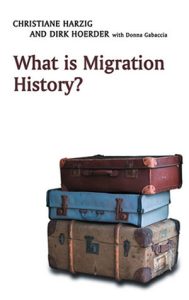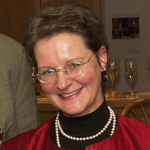What is Migration History?

Author: Christiane Harzig and Dirk Hoerder with Donna Gabaccia
Publisher: Polity Books
Year of Publication: 2009
Print Length: 200 pages
Genre: Non-Fiction / History
Area: Africa, Asia, Asia-Pacific, Atlantic, Ottoman Empire, Mediterranean, Middle East, North America, South/Latin America, Europe
The study of migration is and always has been an interdisciplinary field of study, vast and vibrant in nature. This short introduction to the field, written by leading historians of migration for student readers, offers an acute analysis of key issues across several disciplines. It takes in its scope an overview of migrations through history, how classic theories have interpreted such movements, and contemporary topics and debates including transnational and transcultural lives, access to citizenship, and migrant entrepreneurship.
Historical perspectives reveal how the scholarly field emerged and developed over time and across cultures and how historians of migration have recently begun to re-write the story of human life on earth. Throughout, the authors suggest how the movements of millions of mobile men and women persistently challenge changing scholarly paradigms for understanding their lives. Key concepts and theories, such as systems, networks, and gender, are explained and historicized to produce a complex picture of the interaction of migrants, scholars, and disciplinary cultures in a globalized world.
Topics
Era & Framework:
Imperialism, Colonialism & Post-Colonialism, Industrialization, World War II; Modernity, Modernism, Modern; Postmodernity, Postmodernism, Postmodern; Decolonization & Anti-Colonization
System, Methods, and Tools:
System, Policy & Practice, Politics & Power, Geopolitics, Economy, Trade, History, Asylum & Refugee System, Immigration Control, Immigration System, Citizenship, City & Urban, Development, Apartheid, Battle & Conquest, Borders, War, Civil War, Violence & Mass Violence, Discrimination, Genocide, Labor & Contract, Intersectionality, Minority Rights, Challenges & Opportunities
Identities:
Demography & Population Studies, Age and Generation, Family, Class, Gender, Nation, Race, Sexuality, Religion, Islam
Objects and Phenomenon:
Migration, Refugees & Forced Migration, Asylum & Asylum Seekers, Diaspora, Exile & Exodus, Freedom to Move and to Stay, Movement of People and Ideas, Mobility & Immobility, Interconnectedness, Social Network, Culture & Society, Cultural Heritage/Legacy, Interculturalism, Art & Design, Diversity, Acculturation, Assimilation, Belonging, Deserving & Undeserving, Slavery, Independence & Liberation; Self-Determination, Autonomy, Agency; Racism & Anti-Racism, Gender-based Violence, Global North, Global South, Civilization, Globalization, Governance, State Formation, Nation-Building & Nationhood, Racist Nationalism, Epidemic, Environmental Degradation, Equality & Inequality, Financial & Social Remittances, Market, Pilgrimage, Religious Conversion, Receiving Country, Sending Country, Subaltern, United Nations, Urbanization, Transcultural, Transnationalism, Transregional
Table of Contents
Detailed Contents
List of Maps
Preface
1. Introduction: Popular Views — Scholarly Reconceptualizations
Limitations of scholarship to the 1970s / Unanswered questions / From cliches to differentiation / Revising the emigration-immigration dichotomy / Home and host societies and racializations / The “body parts”-approach to labour migrants / Differentiating push and pull / How do people travel? / Do migrants carry “cultural baggage” or are they “uprooted”? / Are fears of migrants by resident peoples plausible?
2. Migration in Human History — The Long View
Introduction
The periodization of migrations / Time scales
2.1. Deep Time: Homo sapiens Migrates from East Africa across the World
Scholarly disciplines involved in tracing Homo sapiens migrations / Types of migrations / Migrants’ capabilities and the three major phased of migration
2.2. Population Change and Mobility during the “Agricultural Revolution,” 15.000-5000 BP
First phase: domestication of plants and demographic consequences / Second phase: cross-cultural and colonizer migrations / Processes of acculturation
2.3. Cities, Civilizations, and Seaborne Migrations, c. 5000 BCE to 500 CE
Domestication of pack animals and increased mobility / The emergence of towns and cities / Commercial connections across Eurasia and the Mediterranean / Urbanization from Egypt to South Asia and the Indian Ocean connections / Intensification of migration and road construction / Emergence of early empires, migration, refugee-generating warfare / Mobilization of bound labour for ceremonial sites / City walls and admission practices / New concepts of spirituality, pilgrimages, religious flight / Conversion and diaspora-formation
2.4. Migrations and Societies, 500 BCE to 1500 CE
Migrants’ “funds of knowledge” and “bumping” into each other / Migrations in Mesoamerica / African people’s migrations and mobility in bondage / The Mediterranean World: mobility, warfare, empire-building, ethnogenesis / Islamic migrations / Migration in West Central Europe / Migration of Scandinavian peoples to Vinland, Kiev, and Sicily / Trans-Asian mobile peoples / Migrants in many-cultured Chinese cities / The “Black Death” in the ecumene
2.5. Two Worlds into One: Migrations, Trading Circuits, and Cultures in Contact, 1400 to 1600
Chinese missions across the Indian Ocean, the Chinese diaspora, and the court’s ban on outreach / Portuguese trading along the coasts of Africa and the court’s support for such missions / Mediterranean seafarers with heavily armed vessels reach the Americas and the Indian and Pacific oceans / Conquistadores and genocide or near-genocide: conquering and depopulating the Americas / The Columbian exchange, the plantation regime, and slave migrations / The transpacific galleon trade and cultural mixing in the Spanish-ruled world / Interpretations: conversion and world systems
2.6. People on the Move in Self-Ruled, Colonized, and Colonizer Societies, 1600 to 1800
European dominance, imposed unequal terms of trade, and culturally knowledgeable mediators / Case study: From Chinese porcelain to Chinoiserie to Dutch pottery / Worldwide peasant migrations / Migration and cultural coexistence in the Ottoman Empire, the hinge region between East and West / Migration from Europe to the Americas / Forced migration in and from Africa / Interrelatedness of migrations
2.7. Global Migration Systems in the Nineteenth Century
Four major migration systems / The Atlantic outmigration regions and destinations / The slow end of slave migrations and slavery / Asian contract labour migrations / The Russo-Siberian migrations / Comparative volume of migrations / Acceleration of out-migration during the late nineteenth-century agrarian crisis / Migrants’ expectations
2.8. Refugee-Generation, Unmixing of Peoples, and Forced Labour Migrations in the First-Half of the Twentieth Century
Empires, nations, and the admission of migrants to citizenship / The “unmixing” of peoples in the early twentieth century / Students’ migrations to the colonizer cores: discrimination and new transcultural concepts / World War II and refugees / The end of free labour migrations in the 1920s and forced labour regimes from the 1930s
2.9. Decolonization and New Global Patterns of Migration since the 1950s
Colonized peoples’ wars of liberation and resulting migrations / The North-South divide and recolonization under unequal terms of trade / Reverse migrations / Displacement migrations / New labour migrations / Global inequalities / New migrations in Europe / New migrations in North America and Latin America / New migrations in Asia and the Pacific migration system / New migrations toward the oil-producing Gulf states / New migrations in sub-Saharan Africa / New migrations in Eastern Europe
Bibliography
3. Theories of Migration and Cultural Interaction
Introduction
3.1. Theory and Practice from the 1880s to the 1950s
Ravenstein’s “laws” of migration / Social workers’ empirical data on immigrant neighbourhoods and insertion / “Social problems”, population planners, and racializing approaches / The Chicago School of Sociology, 1910s-1920s, especially Park and Thoma/Znaniecki / European developments, racializing demographies / Ethnography of emigration regions in Poland / Worldwide migration statistics, c. 1930 (Willcox/Ferenci) / The 1940s/1950s “uprootedness” paradigm of O. Handlin (nation-to-ethnic enclave), contrasted with / Caroline Ware’s New York neighbourhood study
3.2. Neo-Classical Economics and the Push-Pull Model
Neo-classical macro-level studies, wage differentials, generic push-pull models / Neo-classical micro-level rational choice theory / Assessment
3.3. Innovative Concepts of Transculturation, 1930s-1950s
Early understandings of transnational composition of nations (US) / Theories of transculturation in Latin America and the Caribbean, 1930s-1950s / Concepts of cultural interaction in Canada, 1940s and 1950s
3.4. Towards a Typology of Migrations in Modern Times
Types by human agency: free (in the frame of economic constraints), involuntary (refugees), and forced (slavery, twentieth-century forced labour) / Characteristics by distance: short-, medium-, and long-distance migrants and selectivity in the locality or region of origin / Types by intended duration of stay: seasonal, short-term, long-term, unintentionally permanent, permanent
3.5. Compartmentalization of Research by Type of Migration
Slavery / Indentured labour / Refugees
3.6. New Approaches since the 1970s: World Systems, Family Economics, and Labour Markets
The macro-level: world systems theory / The micro-level: family economies and new economics of labour migration / The meso-level: Labour market theory
3.7. Recent Approaches: Agency, Networks, and Human and Social Capital
Structural, habitus / Human capital, strategic competence / Social capital / Network theory / Mental maps, diaspora, “scapes” of migration
3.8. Transnational Approaches and Transcultural Societal Studies
Transnational / Transregional / Transcultural
Bibliography
4. A Systems Approach to Migrant Trajectories
Introduction
Definition of “systems approach”, contrast to “migration systems” / Special case: Forced migrations
4.1. Structures and Agency: Contextualizing Migration Decisions
Migrants’ socialization and region-specific belonging / Linkages between micro-regions of departure and arrival, resulting “mental maps” / Decision-making frames
4.2. The Society of Departure
Migration-inducing factors / Demographic transition, urbanization, and industrialization / Stratification and class structures / Traditions of migration as facilitating factors / Stateside emigration regulations / Immigration restrictions from the late nineteenth century on Asian exclusion / Stateside discrimination against resident minorities as migration-inducing factor / States’ colonial expansion and migration / Migration and social cost for child-rearing and care for the elderly / Stateside shipping out of undesirables and migration-inducing inequalities
4.3. Votages: Extended, Compressed, Delayed
Obstacles and inducements to migration, including racial discrimination / Facilitation: information flows and prepaid tickets / Agency-arranged “package tours” for labour migrants / Voyaging and adjustment / Recent “border” control systems / Refugee rejection and “global apartheid”
4.4. The Receiving Society: Economic Insertion, Acculturation, Politics, and New Belongings
Assimilation as a nation-state project / Race and acculturation / Generations and acculturation / Three stages of acculturation: economic, societal, political / Acculturation: definition and variants (accommodation, insertion) / The economic sphere and income security, standard of life / The social sphere, gender, minority status, living conditions / The political sphere / Model of assimilation (Gordon) or acculturation (Goldlust/Richmond) / A model for institutional pluralism
4.5. Global Interdependence and Transcultural Lives
Transcultural structures and lives in the past / Transoceanic connectivity in the nineteenth century / The debate about transnational and transcultural in the present / Transnational lives and belonging
Bibliography
5. Migrant Practices as a Challenge to Scholarship
Introduction
Migrant experiences versus research dynamics
5.1. Race and Mobility
The social and legal differentiation of people by “race” over time / “Scientific” racism / Racism and European imperial expansion / Ethnogenesis / Migration after decolonization and “whiteness” and “subaltern” studies
5.2. Gender and Mobility
Male-female rations in migration / Present-day women caregivers’ migrations / Older interpretations of women’s migrations / Children’s refugee migrations / Women’s migration and gender relations in societies of departure and arrival / Changing gendered division of tasks / Migration and sexualities
5.3. Transnational and Translocal Families
Separation by migration and communication / Multiple family perspectives / Reproduction of family ties over long distances / Allocation of “mothering” roles when women migration / Reallocation of labour among those remaining behind / Remittances and family lifestyles / Family formation, diasporas, and nations
5.4. Bringing the State Back In
Governments and migrants: labelling or policy-making / State power and migrations before the nineteenth century / Nation-states and (forced) mobility in the first half of the twentieth century / Citizenship: ius soli and ius sanguinis / Entry restrictions since the end of the nineteenth century / League of Nations and United Nations’ declarations about migrants’ rights / Migration regimes and migrants’ perspectives
Bibliography
6. Perspectives in the Early Twenty-First Century
Introduction
6.1. Gendered and Racialized Labour and Refugee Migrations in the Present
Directions of macro-regional migrations: industrialized versus lesser industrialized regions / Global economic disparities / Export of production facilities and resulting migrations / Labour reservoirs and refugee generation / Refugees from violence and warfare / Refugees from environmental degradation / Refugees displaced by development / Geneva Convention status of refugees and agency of potential refugees / Gendered patterns of migration and gendered patterns of research
6.2. Inclusion Strategies: Citizenship and Belonging
Inclusive and exclusive citizenship regimes since the age of democratic revolution: political human rights / The juxtaposition of migrants and bounded states / Social human rights, 1930s-1960s, and “denizen” status / Human rights: from Atlantic World to universality / The critique of “loyalty” to and monolingualism in a state / The meaning of citizenship at the turn of the twenty-first century / Diversity and migrant belonging / Access to citizenship / Recent anti-immigrant movements / Multi-coloured and -cultured people
6.3. Migrants’ Identifications at the Beginning of the Twenty-First Century
Primary and secondary socialization / Adapted or bifurcated identities / Transcultural lives / Belonging and embeddedness versus vertical hierarchization / Multiple identifications / “Fusion” and young people / Deterritorialization and commonalities / Universalist views versus ethnic specificity and conflict / Conclusion: Multiple options
Bibliography
Notes
Index

Christiane Harzig used to be Associate Professor at Arizona State University, teaching history of migration and women. She has worked in several places, including Germany and the United States. She passed away in 2007 before finishing her work with her husband, What is Migration History? (Polity Books, 2009) Studies because of cancer. Donna Gabaccia, her friend since 1979, helped complete her parts she could no longer write.
Source: https://www.jstor.org/stable/27501734
More from Christiane Harzig in this library, click here.

Dirk Hoerder has taught US and Canadian social history, global migration studies, and sociology of migrant acculturation at the University of Bremen (1977-2008) and Arizona State University (2007-2011). His publications include Cultures in Contact: World Migrations in the Second Millennium (2002) and What is Migration History? (2009). He is Emeritus Professor at Arizona State University.
Source: https://brill.com/display/title/69374?language=en & https://search.asu.edu/profile/984416
More from Dirk Hoerder in this library, click here.

Donna Gabaccia is Professor Emerita at Department of History, University of Toronto. She is well-known around the world as a scholar of international migration, gender and food studies and for her interdisciplinary and digital history collaborations with scholars, librarians, and students. She has written and edited fifteen books on U.S. immigration, migration in world history, and the history of the worldwide Italian diaspora. She is the past president of the Social Science History Association and the Society for the History of the Gilded Age and Progressive Era, and recipient of many awards and honours including the 2013 University of Minnesota Community Service Award for Faculty, which acknowledged her work with immigrant and refugee communities.
Gabaccia’s most recent book, Gender and Migration: From the Slavery Era to the Global Age, co-authored with Vanderbilt University sociologist and demographer Katharine Donato, won honourable mention in 2016 from the American Sociological Association International Migration Section’s Thomas & Znaniecki Best Book Award, placing her among the very small group of historians whose work has been honoured with recognition from Sociology.
Source: https://www.history.utoronto.ca/people/directories/all-faculty/donna-gabaccia
More from Donna Gabaccia in this library, click here.
